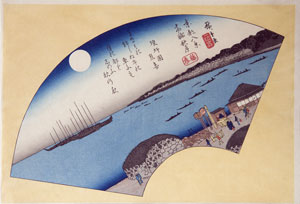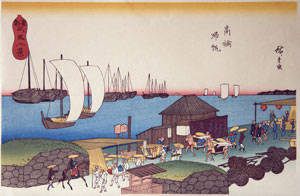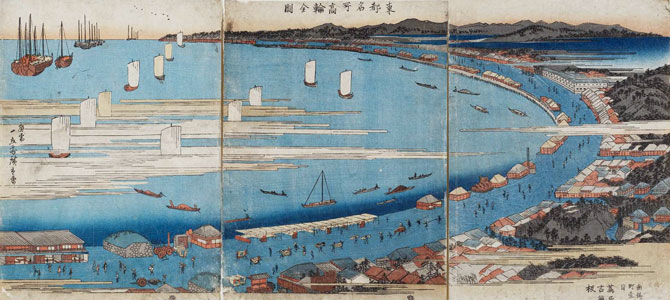
|
|

|
Hokusai - Ehon Sumida Gawa - Prints 1-1 and 1-2

|
|

|
The time is the dawn of the first day of the New Year somewhere around 1800. The place is Ōkido in the Takanawa (高輪) district of Musashi province, located at the south-east of Edo, the capital of Japan. Ōkido is written in Japanese as 大木戸, which translates into “large wooden gate”.
In 1770 this wooden gate was replaced by the stone gate shown at the bottom of print 1-2 (click to enlarge, and then click again to enlarge even further). This is the last gate that travelers from Kyoto along the Tōkaidō road had to pass before entering Edo, and where they had to show their travel documents. Traditionally, the Ōkido is also the place where relatives and friends said their farewells to people travelling west from Edo along the Tōkaidō road. The Takanawa district marks the start of the shitamachi (下町, meaning “downtown”) area of Edo.
At that time the city of Edo was divided into two major parts: the low city, the shitamachi on the one hand, and the high city, the yamanote (山の手) on the other. The yamanote, the more elevated part and the hills, were inhabited by the daimyō and military class, with the castle of the shōgun (the top military commander) at its center. The shitamachi or lower parts, the districts close to Edo Bay and bordering on the Sumida river, were inhabited by the other half of the city’s population, consisting of merchants and artisans.
The stern of the large sea vessel in the mid distance of print 1-2 is a maritime display of a kadomatsu. A kadomatsu (門松, literally meaning “gate pine”) is a traditional Japanese decoration of the New Year placed in pairs in front of homes to welcome ancestral spirits or kami of the harvest. They are placed after Christmas until January 7 (or January 15 during the Edo period) and are considered temporary housing for these ancestral spirits. Designs for kadomatsu vary depending on region but are typically made of pine, bamboo, and sometimes ume tree sprigs which represent longevity, prosperity, and steadfastness, respectively. After January 15 (or in many instances the 19th) the kadomatsu is burned to appease the ancestral spirits and release them.
In the further distance Hokusai shows the curvature of the western coast forming Edo bay with the town of Shinagawa in print 1-1, followed by the snow capped Mount Fuji in the far distance of print 1-2.
The Takanawa Ōkido gate has been the subject of many Japanese prints, one of them being the fan print on the left from the series “Eight Views of Edo” and another one being a print from the series “Eight Views of Shiba in the Eastern Capital” on the right, both designed by Utagawa Hiroshige (click to enlarge):

|

|
| Autumn moon at Takanawa by Utagawa Hiroshige (ca 1840) |
Returning sails at Takanawa by Utagawa Hiroshige (ca 1840) |
This triptych, also by Hiroshige, provides a complete view of Takanawa including the Ōkido gate (click to enlarge):

|
Complete view of Takanawa from the series “Famous places |
These prints clearly indicate that the stone walls of the Takanawa Ōkido gate were located on both sides of the Tōkaidō road.
The remains of the Takanawa Ōkido stone gate can still be seen today. They are located a twenty minutes walk north from Shinagawa train station on the eastside of Route 15 (the Daiichi Kei-hin, the route connecting Tokyo and Yokohama). Here are a few pictures I took of the gate in 2017 (click to enlarge):
.jpg)
|
.jpg)
|
.jpg)
|
.jpg)
|